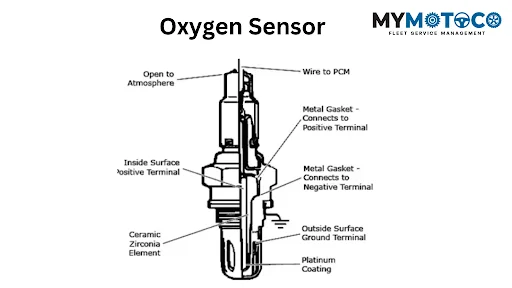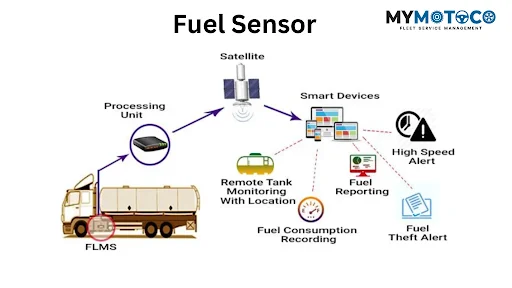भारत में कमर्शियल वाहन ट्रकों में विभिन्न प्रकार के सेंसर की भूमिका
भारत में कमर्शियल वाहनों इंडस्ट्री ने नई तकनीकों एक साथ जुड़ने से एक बड़ा परिवर्तन देखा है। इनमें से एक महत्वपूर्ण विकास विभिन्न सेंसर का उपयोग है, कमर्शियल वाहन ट्रकों में विभिन्न प्रकार के सेंसर जो ट्रकों की दक्षता, सुरक्षा और प्रदर्शन को बढ़ाने में मदद करते हैं। ये सेंसर वाहन के स्वास्थ्य की निगरानी करते हैं, ईंधन दक्षता को अनुकूलित करते हैं, ड्राइवर की सुरक्षा सुनिश्चित करते हैं और नियम का पालन करने में मदद करते हैं। इस ब्लॉग में, हम कमर्शियल ट्रकों में उपयोग किए जाने वाले विभिन्न प्रकार के सेंसर, उनके कार्य, भारतीय ट्रकिंग उद्योग में उनकी महत्वता, चुनौतियाँ के बारे में चर्चा करेंगे।
विभिन्न प्रकार के सेंसर और उनके कार्य:
1. इंजन और परफॉर्मेंस सेंसर:
- मास एयर फ्लो (MAF) सेंसर: यह सेंसर इंजन में प्रवेश करने वाली हवा की मात्रा को मापता है, जिससे सही एयर-फ्यूल मिश्रण सुनिश्चित किया जाता है। इससे ईंधन दक्षता बढ़ती है और प्रदूषण कम होता है।
- मैनिफोल्ड एब्सोल्यूट प्रेशर (MAP) सेंसर: यह सेंसर इंजन लोड की निगरानी करता है और इनटेक मैनिफोल्ड में वायु दबाव को मापता है। यह फ्यूल इंजेक्शन और इग्निशन टाइमिंग को एक करने में मदद करता है।
- ऑक्सीजन (O2) सेंसर: यह सेंसर एग्जॉस्ट गैसों में ऑक्सीजन के स्तर की निगरानी करता है, जिससे ईंधन खपत को मापा जाता है और हानिकारक इमीशन को कम किया जाता है।
- कूलेंट टेम्परेचर सेंसर: यह इंजन के तापमान की निगरानी करता है, जिससे ओवरहीटिंग रोका जाता है और कूलिंग सिस्टम की कार्यक्षमता सुनिश्चित होती है।
2. सुरक्षा और ड्राइवर सहायता सेंसर:
- एंटी-लॉक ब्रेकिंग सिस्टम (ABS) सेंसर: यह सेंसर ब्रेक लगाने के दौरान पहियों को लॉक होने से रोकता है, जिससे स्थिरता बनी रहती है और दुर्घटना का जोखिम कम होता है।
3. ईंधन और इमीशन मॉनिटरिंग सेंसर:
- फ्यूल लेवल सेंसर: यह टैंक में ईंधन के स्तर की निगरानी करता है, जिससे फ्लीट मैनेजर ईंधन की खपत को ट्रैक कर सकते हैं और ईंधन चोरी को रोक सकते हैं।
- NOx सेंसर: यह सेंसर नाइट्रोजन ऑक्साइड (NOx) इमीशन को नियंत्रित करने में मदद करता है, जिससे प्रदूषण कम होता है।
4. भार और सस्पेंशन सेंसर:
- लोड सेंसर: यह ट्रक के भार को मापता है ताकि ओवरलोडिंग को रोका जा सके, जिससे यांत्रिक विफलताओं और कानूनी समस्याओं से बचा जा सके।
- सस्पेंशन हाइट सेंसर: यह ट्रक के सस्पेंशन सिस्टम की निगरानी करता है, जिससे विभिन्न भार स्थितियों में सुचारू संचालन और स्थिरता सुनिश्चित होती है।
5. ट्रैकिंग और फ्लीट प्रबंधन सेंसर:
- GPS और वाहन ट्रैकिंग सेंसर: ये सेंसर वास्तविक समय में वाहन की लोकेशन ट्रैक करने में मदद करते हैं, जिससे फ्लीट ऑपरेटर वाहन की गतिविधि की निगरानी कर सकते हैं और लॉजिस्टिक्स में सुधार कर सकते हैं।
- टायर प्रेशर मॉनिटरिंग सिस्टम (TPMS) सेंसर: यह सेंसर टायर के दबाव की निगरानी करता है और ड्राइवर को कम या अधिक हवा के बारे में अलर्ट करता है, जिससे ईंधन दक्षता और सुरक्षा में सुधार होता है।
6. पर्यावरण और मौसम निगरानी सेंसर:
- एयर क्वालिटी सेंसर: यह सेंसर प्रदूषकों की निगरानी करता है और ड्राइवरों के लिए केबिन में स्वच्छ हवा बनाए रखने में मदद करता है, जिससे स्वास्थ्य संबंधी जोखिम कम होते हैं।
- तापमान और ह्यूमिडिटी सेंसर: ये सेंसर केबिन के वातावरण को बनाए रखने में मदद करते हैं और तापमान संवेदनशील वस्तुओं के लिए अनुकूल संचालन सुनिश्चित करते हैं।
कमर्शियल वाहनों में सेंसर का महत्व
- सुरक्षा: सेंसर दुर्घटनाओं को रोकने में महत्वपूर्ण भूमिका निभाते हैं और वाहन व ड्राइवर के व्यवहार की निगरानी करते हैं।
- सरकारी नियमों का पालन: कई सेंसर ट्रकों को BS6 जैसे सख्त इमीशन मानदंडों का पालन करने में मदद करते हैं।
- ईंधन दक्षता: इंजन और ईंधन मॉनिटरिंग सेंसर ईंधन खपत को अनुकूलित करते हैं, जिससे परिचालन लागत कम होती है।
- रखरखाव: सेंसर छोटी समस्याओं का पहले से पता लगाते हैं, जिससे डाउनटाइम और मेंटेनेंस लागत कम होती है।
- फ्लीट ट्रैकिंग: GPS और ट्रैकिंग सेंसर फ्लीट ऑपरेटरों को लॉजिस्टिक्स अधिक कुशलता से प्रबंधित करने में मदद करते हैं।
सेंसर तकनीक लागू करने की चुनौतियाँ
- उच्च उत्पादन लागत: उन्नत सेंसर सिस्टम में निवेश की आवश्यकता होती है, जो छोटे फ्लीट ऑपरेटरों के लिए चुनौतीपूर्ण हो सकता है।
- जटिल रखरखाव: सेंसर को सही तरीके से कार्य करने के लिए नियमित रखरखाव की आवश्यकता होती है।
- मजबूती: भारत की सड़कों की खराब स्थिति और कठोर मौसम सेंसर के प्रदर्शन और जीवनकाल को प्रभावित कर सकते हैं।
- सीमित जागरूकता: कई फ्लीट ऑपरेटर और ड्राइवर अभी भी सेंसर-आधारित तकनीकों के लाभों और उनके सही उपयोग से अनजान हैं।
निष्कर्ष
सेंसर ने भारतीय ट्रकिंग इंडस्ट्री को विकसित किया है और वाहन के प्रदर्शन, सुरक्षा और दक्षता को बढ़ाया है। BS6 जैसे सख्त इमीशन मानदंडों और ट्रैकिंग तकनीकों के बढ़ते उपयोग के साथ, सेंसर की भूमिका और भी महत्वपूर्ण हो रही है। सेंसर तकनीक फ्लीट ऑपरेटरों को परिचालन लागत कम करने, नियमों का पालन करने और सड़क सुरक्षा सुनिश्चित करने में मदद मिल सकती है। जैसे-जैसे तकनीक विकसित हो रही है, भारतीय ट्रकिंग इंडस्ट्री स्मार्ट और अधिक कुशल सेंसर-आधारित समाधानों के साथ आगे बढ़ता रहेगा।
MyMotoCo में, हम कमर्शियल वाहनों के लिए उच्च गुणवत्ता वाले ऑटोमोटिव स्पेयर पार्ट्स और सेंसर समाधान प्रदान करते हैं, जिससे बेहतरीन प्रदर्शन और विकसित इंडस्ट्री नियमका पालन सुनिश्चित होता है। अपने फ्लीट के लिए हमारे ऑटोमोटिव प्रोडक्ट्स की विस्तृत रेंज को एक्सप्लोर करने के लिए MyMotoCo पर जाएं।
The Role of Different Type of Sensors in Commercial Vehicle Trucks in India
The commercial vehicle industry in India has witnessed major transformation with the integration of advanced technologies. One of the important developments is the use of various sensors that enhance the efficiency, safety, and performance of trucks. These sensors play an important role which monitors vehicle health, optimizes fuel efficiency, ensures driver safety, and follows regulatory requirements. In this blog, we will explore the different types of sensors used in commercial trucks and their functions, importance and challenges in the Indian trucking industry.
Different Types of Sensors and their functions:
1. Engine and Performance Sensors:
- Mass Air Flow (MAF) Sensor: The MAF sensor measures the amount of air which enters in the engine to ensure correct air-fuel mixture for combustion. This improves fuel efficiency and reduces emissions.
- Manifold Absolute Pressure (MAP) Sensor: The MAP sensor monitors engine load by measuring air pressure in the intake manifold. It helps in adjusting fuel injection and ignition timing.
- Oxygen (O2) Sensor: This sensor monitors the oxygen levels in the exhaust gases to measure fuel consumption and reduce harmful emissions.
- Coolant Temperature Sensor: It helps monitor engine temperature which prevents overheating and ensuring efficient cooling system performance.
2. Safety and Driver Assistance Sensors:
- Anti-lock Braking System (ABS) Sensor: ABS sensors prevent wheel lock-up during braking, ensuring stability and reducing the risk of accidents.
3. Fuel and Emission Monitoring Sensors:
- Fuel Level Sensor: It monitors fuel levels in the tank, helping fleet managers track fuel consumption and prevent fuel theft.
- NOx Sensor: NOx sensors help in reducing nitrogen oxide (NOx) emissions by controlling the emissions from exhaust gases.
4. Load and Suspension Sensors:
- Load Sensor: Load sensors measure the weight of trucks to prevent overloading, which can cause mechanical failures and legal issues.
- Suspension Height Sensor: This sensor monitors the truck’s suspension system to ensure smooth handling and stability under different load conditions.
5. Tracking and Fleet Management Sensors
- GPS and Vehicle Tracking Sensors: These sensors provide real-time location tracking, helping fleet operators monitor vehicle movement and improve logistics.
- Tire Pressure Monitoring System (TPMS) Sensor: TPMS sensors check tire pressure and alert drivers about under-inflated or over-inflated tires to improve fuel efficiency and safety.
6. Environment and Weather Monitoring Sensors:
- Air Quality Sensor: Air quality sensors monitor pollutants and help maintain a clean cabin environment for drivers, reducing health risks.
- Temperature and Humidity Sensors: These sensors help to maintain cabin climate and ensure optimal operating conditions for temperature sensitive fleets.
Importance of Sensors in Commercial Vehicles
- Safety: Sensors play an important role in preventing accidents by monitoring vehicle and driver behavior.
- Follow Government Rules: Many sensors help trucks follow strict emission norms like BS6 in India.
- Fuel Efficiency: Engine and fuel monitoring sensors optimize fuel consumption, reducing operational costs.
- Maintenance: Sensors detect issues before they become major and minimise downtime and maintenance expenses.
- Fleet Tracking: GPS and tracking sensors help fleet operators manage logistics more efficiently.
Challenges in Implementing Sensor Technology
- High Production Cost: Advanced sensor systems require more investment which makes it more challenging for small fleet operators.
- Complex Maintenance: Regular maintenance is required to keep sensors function correctly.
- Durability: Rough Indian road conditions and extreme weather can affect sensor performance and lifespan.
- Limited Awareness: Many fleet operators and drivers are still unaware of the benefits and correct usage of sensor-based technologies.
Conclusion
Sensors have developed the trucking industry in India by improving vehicle performance, safety, and efficiency. With strict emission norms like BS6 and increasing adoption of tracking, the role of sensors is developing more. Investing in sensor equipped trucks can help fleet operators to reduce operational costs, follow regulations, and ensure road safety. As technology evolves, the Indian trucking industry will continue to develop with smarter and more efficient sensor-based solutions.
At MyMotoCo, we provide high-quality automotive spare parts and sensor solutions for commercial vehicles, ensuring optimal performance and compliance with the latest industry standards. Visit MyMotoCo to explore our wide range of automotive products for your fleet.


